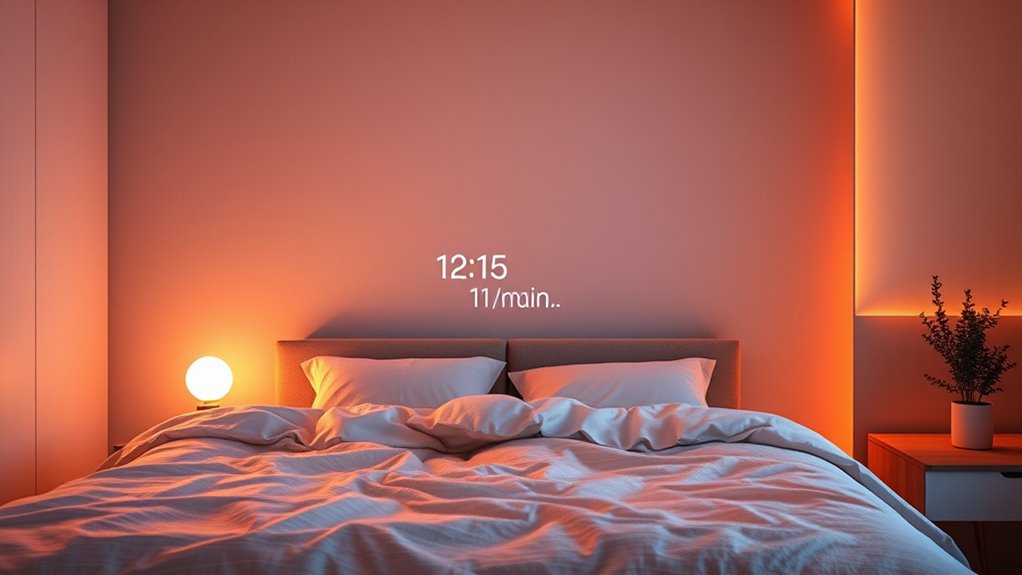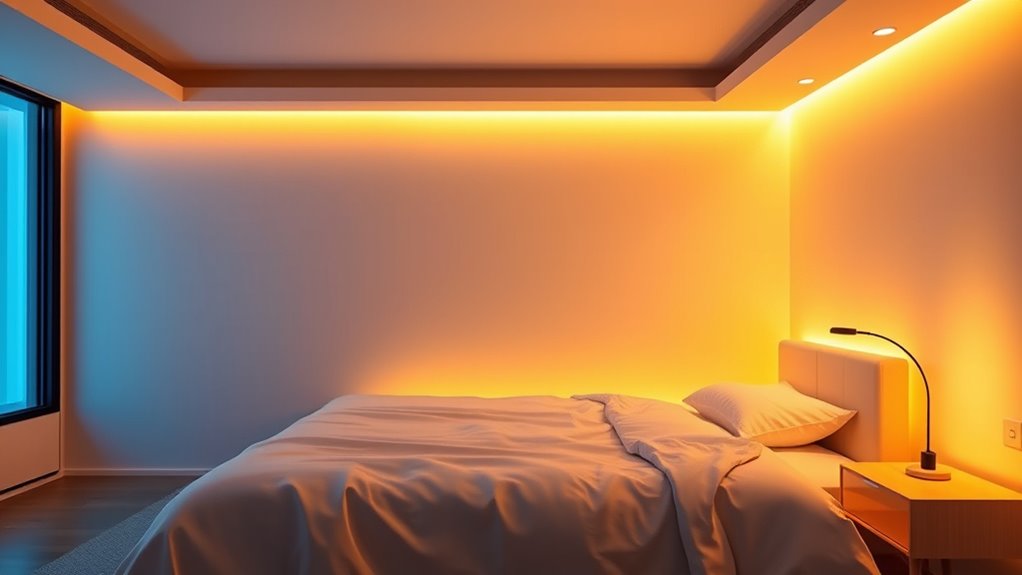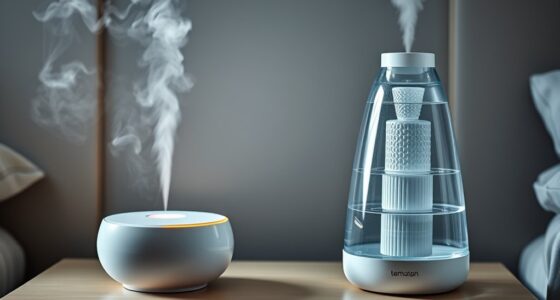Smart lighting bulbs that mimic natural light patterns can help sync your indoor environment with your body’s internal clock. They adjust brightness and color temperature throughout the day, providing energizing blue light in the morning and warm tones in the evening. This supports your circadian rhythm, improves sleep, and boosts overall well-being. By choosing the right smart lighting, you can better align your daily routines with your biological needs—and there’s more to discover if you keep exploring.
Key Takeaways
- Smart bulbs can adjust color temperature and brightness to mimic natural daylight patterns, supporting your circadian rhythm.
- These bulbs gradually transition from cool, blue-enriched light in the morning to warm, soft hues in the evening.
- Syncing lighting schedules with your daily routine helps regulate sleep-wake cycles and improve overall health.
- Reducing blue light exposure in the evening with circadian-friendly bulbs aids melatonin production and sleep quality.
- Compatible smart lighting systems can be controlled via apps to optimize light exposure based on your body’s internal clock.

Lighting plays a crucial role in regulating your body’s internal clock, known as the circadian rhythm. When your environment mimics natural light patterns, it can substantially influence your sleep-wake cycle, alertness, and overall health. This is where smart lighting comes into play. Unlike traditional bulbs, smart lighting systems can adjust their brightness and color temperature throughout the day, aligning better with your body’s natural rhythms. By mimicking the changing light levels from sunrise to sunset, these innovative lighting solutions help you stay alert during the day and wind down in the evening.
Smart lighting adjusts brightness and color to support your body’s natural sleep-wake cycle.
When you incorporate smart lighting into your daily routine, you’re actively supporting your sleep improvement efforts. During the morning hours, smart bulbs can emit a gentle, bluish light that resembles natural daylight, which helps suppress melatonin production and boosts alertness. As evening approaches, the lighting gradually shifts to warmer, softer hues, signaling to your body that it’s time to wind down. This gradual change reduces the likelihood of your circadian rhythm being disrupted by harsh, artificial lighting, making it easier for you to fall asleep at night.
Smart lighting systems often sync with your daily schedule or can be controlled via smartphone apps, giving you the flexibility to customize your environment. This means you can set your lights to gradually brighten in the morning, mimicking sunrise, or to dim in the evening, mimicking sunset, without any manual effort. By doing so, you’re creating a consistent light pattern that reinforces your body’s natural sleep-wake cycle, ultimately fostering better sleep quality and daytime productivity.
Additionally, smart lighting can help prevent sleep disturbances caused by exposure to blue light from screens, especially in the hours leading up to bedtime. Many smart lighting solutions allow you to switch to warmer, less stimulating tones that reduce blue light exposure, helping your body prepare for restful sleep. This strategic adjustment can lead to longer, more restorative sleep sessions, which are essential for physical health, cognitive function, and emotional well-being.
Frequently Asked Questions
Can Circadian Lighting Improve Sleep Quality for Shift Workers?
You might find that circadian lighting can improve your sleep quality as a shift worker. Light therapy helps reset your internal clock, making it easier to fall asleep and stay rested. Incorporating good sleep hygiene habits complements this, reducing disruptions. Using bulbs that sync with your body clock creates an environment conducive to better rest, even with irregular hours. This combination supports your overall sleep health and daytime alertness.
Are Circadian Bulbs Safe for Children and Pets?
Imagine your child happily playing under a gentle, circadian bulb that adapts to their sleep cycle. You might wonder if these bulbs are safe for children and pets. Generally, circadian bulbs are designed with child and pet safety in mind, using low levels of blue light. Still, it’s wise to verify product labels and consult safety guidelines to guarantee your little ones and furry friends stay protected.
How Do I Choose the Right Circadian Lighting System?
When choosing the right circadian lighting system, focus on color temperature options that match your daily activities, like warmer tones for evenings and cooler ones for mornings. Look for smart controls that let you adjust brightness and timing easily. Make sure the system is compatible with your existing smart home devices. This way, you can customize your lighting to support your natural body clock while enjoying convenience and comfort.
Can Circadian Lighting Help With Seasonal Affective Disorder (SAD)?
Did you know about 6% of people suffer from Seasonal Affective Disorder (SAD)? Circadian lighting can help improve your mood regulation and boost Vitamin D synthesis during darker months. By mimicking natural sunlight, these lights can lift your spirits and regulate your body’s internal clock, reducing SAD symptoms. You might find that investing in circadian lighting creates a brighter, more balanced winter experience.
What Is the Lifespan of Circadian-Compatible Light Bulbs?
You might wonder about the lifespan of circadian-compatible light bulbs. Generally, these bulbs last between 15,000 to 25,000 hours, offering good bulb longevity. They usually require minimal maintenance, but it’s wise to check for any specific manufacturer recommendations. Proper use and regular cleaning can extend their life, ensuring you get the most out of your investment. Keep an eye on performance to know when it’s time for replacement.
Conclusion
By choosing bulbs that sync with your body clock, you can improve your sleep and overall well-being. Studies show that proper lighting can boost mood and productivity by up to 20%. Imagine waking up refreshed and energized every day—it’s possible with the right lighting. So, why not take control of your environment and align your indoor light with your natural rhythms? Your body will thank you, and you’ll feel better every single day.









